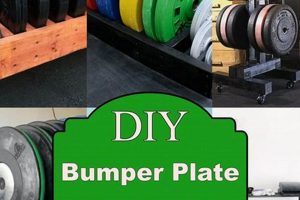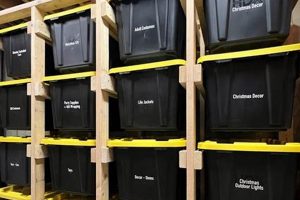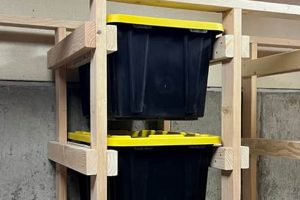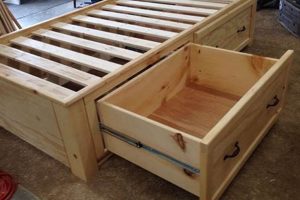Constructing weatherproof containers for external organization offers a customizable approach to managing items kept outside. These receptacles, often built from readily available materials, provide protection from the elements for garden tools, recreational equipment, and seasonal decorations. A simple example includes a repurposed wooden pallet transformed into a chest with a hinged lid, offering sheltered space for cushions and blankets on a patio.
The practice of creating personal external storage solutions addresses the limitations of standardized, commercially produced options. Tailoring the size, shape, and material composition allows individuals to optimize space utilization and aesthetic integration with existing landscapes or architectural features. Historically, resourceful individuals have employed various salvaged materials and construction techniques to meet their storage requirements, demonstrating an understanding of both structural integrity and resourcefulness.
The subsequent discussion will explore various design considerations for constructing long-lasting weatherproof containers, including material selection, weatherproofing methods, and functional enhancements. The focus remains on practical guidance for individuals seeking durable and cost-effective solutions for outdoor organization.
Construction Advice for Weather-Resistant External Compartments
The following guidance assists in the construction of durable receptacles designed to withstand exposure to the elements, thereby ensuring long-term utility and protection of stored items.
Tip 1: Material Selection is Paramount: Employ treated lumber, cedar, or composite materials known for moisture resistance. Untreated wood is susceptible to rot and insect infestation, significantly reducing the structure’s lifespan. For example, pressure-treated pine provides an economical option, while cedar offers natural insect repellent properties.
Tip 2: Prioritize Secure Joinery: Utilize exterior-grade screws and adhesives designed for wet conditions. Mortise and tenon joints, biscuit joints, or robust screw connections enhance structural integrity and prevent separation due to temperature fluctuations and moisture expansion.
Tip 3: Implement Effective Weatherproofing: Apply multiple coats of exterior-grade paint or sealant. Focus on sealing all seams, edges, and joints to prevent water penetration. Consider incorporating a membrane beneath the base to prevent moisture wicking from the ground.
Tip 4: Design for Adequate Ventilation: Incorporate small vents to allow for air circulation, reducing the risk of mold and mildew growth inside the receptacle. Vents should be positioned to minimize water entry while promoting airflow.
Tip 5: Elevate the Structure: Raising the base off the ground using feet or a platform prevents direct contact with moisture and debris. This minimizes the risk of rot and extends the receptacle’s lifespan.
Tip 6: Incorporate a Sloped Lid: Design the lid with a slight slope to facilitate water runoff and prevent pooling. This reduces the stress on the sealing around the lid and minimizes the risk of water infiltration.
Tip 7: Secure the Lid Properly: Implement robust hinges and latches capable of withstanding strong winds and preventing accidental opening. Consider lockable latches for added security against theft or unauthorized access.
Adherence to these construction recommendations enhances the longevity and protective capabilities of the finished structure. Prioritizing appropriate materials, secure joinery, and effective weatherproofing techniques is crucial for safeguarding stored items from the elements.
The subsequent sections of this article will address advanced design considerations, including custom sizing, aesthetic enhancements, and specialized storage configurations.
1. Material Durability
Material durability serves as a foundational element in the design and construction of any self-assembled external storage unit. The inherent capacity of the chosen materials to resist degradation from environmental factors directly determines the overall lifespan and protective efficacy of the structure. The selection of materials lacking inherent resistance to moisture, ultraviolet radiation, or pest infestation invariably leads to premature structural failure, rendering the storage unit ineffective. As an example, using untreated softwood in a region prone to heavy rainfall would result in rapid decay, compromising the integrity of the box and exposing its contents to the elements.
Considerations for material durability extend beyond simple resistance to the elements. The material must also withstand physical stress, such as the weight of stored items or potential impacts. The choice of a thin, brittle plastic for a large storage box designed to hold gardening tools could lead to cracking or breakage under load or due to accidental contact. Furthermore, the interaction between different materials within the construction must be considered. For instance, using dissimilar metals can lead to galvanic corrosion, weakening the structural integrity of the joints over time. Therefore, understanding the material properties and their interaction with the external environment is critical.
In summary, material durability constitutes a non-negotiable aspect of constructing a reliable outdoor storage solution. By prioritizing materials that exhibit inherent resistance to environmental degradation and physical stress, the long-term functionality and protective capacity of the self-assembled unit are significantly enhanced. Neglecting this critical consideration will inevitably lead to premature failure, negating the intended purpose of secure and weatherproof outdoor storage.
2. Weather Resistance
Weather resistance is a paramount attribute in the design and construction of any external storage receptacle. Its effectiveness determines the degree to which stored items are shielded from environmental stressors, directly impacting the lifespan and utility of the container. Failure to adequately address weather resistance leads to material degradation, water damage, and ultimately, the loss or compromise of stored contents. This critical element must be considered from initial design phases through material selection and construction techniques.
- Material Selection and Impermeability
The choice of materials fundamentally dictates the degree of weather resistance achievable. Materials exhibiting inherent impermeability, such as treated lumber, certain plastics, or metals with protective coatings, provide a primary barrier against moisture penetration. For instance, a storage box constructed from untreated plywood will readily absorb moisture, leading to warping, swelling, and eventual delamination, whereas a similar box constructed from high-density polyethylene offers superior water resistance. Proper material selection significantly reduces the reliance on secondary weatherproofing measures.
- Sealing and Joint Integrity
Even with inherently water-resistant materials, gaps and joints represent potential points of water entry. Employing sealants specifically formulated for outdoor use is crucial for creating watertight barriers at seams, edges, and around hardware penetrations. Inadequate sealing allows moisture to infiltrate the interior, creating conditions conducive to mold growth and corrosion. For example, using a marine-grade sealant around the lid of a storage box prevents water from entering during rainfall, protecting the contents from water damage.
- Surface Treatment and Protection
The application of protective coatings, such as paints, stains, or varnishes, provides an additional layer of defense against weathering. These coatings not only enhance the aesthetic appeal of the container but also protect the underlying material from ultraviolet radiation, moisture, and abrasion. A storage box painted with a UV-resistant exterior paint will experience less fading and degradation over time compared to an unpainted box exposed to direct sunlight. Regular maintenance and reapplication of these coatings are essential for sustained protection.
- Drainage and Ventilation Design
Effective weather resistance incorporates design features that facilitate water runoff and promote air circulation. Sloped lids prevent water from pooling on the surface, reducing the risk of leaks. Vents, strategically placed to allow airflow while preventing water ingress, minimize condensation and discourage mold growth inside the container. A storage box with a sloped lid and screened vents allows moisture to escape, keeping the interior dry and well-ventilated, even in humid conditions.
The interplay of these facetsmaterial impermeability, sealing integrity, surface treatment, and drainage/ventilation designcollectively determines the overall weather resistance of a personal storage box. Comprehensive attention to each element ensures that the constructed receptacle provides effective and lasting protection for stored items against the detrimental effects of environmental exposure. Compromising any one facet diminishes the overall effectiveness of the unit, potentially leading to the degradation of both the container and its contents.
3. Structural Integrity
The structural integrity of a self-assembled external storage box is a critical determinant of its long-term performance and protective capabilities. This attribute defines the receptacle’s ability to withstand physical stresses imposed by its contents, environmental factors, and incidental impacts. A failure in structural integrity compromises the container’s functionality, potentially leading to damage or loss of stored items and necessitating costly repairs or replacements. For instance, a storage box constructed with insufficient bracing or weak joints may collapse under the weight of heavy gardening equipment, rendering it useless and potentially damaging the contents.
Several factors contribute to the structural integrity of a do-it-yourself external storage solution. The choice of materials plays a significant role, as denser and more robust materials inherently possess greater load-bearing capacity. Proper joint construction, employing techniques such as mortise-and-tenon joints or reinforced screw connections, ensures that the individual components of the box act as a cohesive unit. Internal bracing and support structures distribute weight evenly and prevent warping or sagging over time. The design must account for anticipated loads and stresses, incorporating appropriate safety margins to prevent structural failure under adverse conditions. Consider the scenario of a storage box exposed to heavy snow loads; a poorly designed roof structure may buckle under the weight, while a properly reinforced design will maintain its integrity.
In conclusion, structural integrity is not merely a desirable feature but a fundamental requirement for any successful external storage box. Prioritizing robust materials, sound construction techniques, and thoughtful design considerations ensures that the container can effectively withstand the rigors of outdoor use, providing reliable and long-lasting protection for its contents. Neglecting this aspect can lead to premature failure, rendering the entire endeavor a futile exercise in resource expenditure. The careful consideration of structural factors ultimately translates into a durable and dependable storage solution.
4. Ventilation Design
Ventilation design represents a critical consideration in the construction of self-assembled external storage solutions. Adequately managed airflow mitigates moisture accumulation, preventing the proliferation of mold, mildew, and rot, thereby safeguarding stored items and prolonging the lifespan of the structure itself. Effective ventilation strategies are essential for maintaining a dry and stable internal environment.
- Airflow Principles and Moisture Control
The fundamental principle underpinning ventilation design involves promoting continuous air circulation to expel moisture-laden air and introduce drier, ambient air. Without adequate airflow, humidity levels within the enclosure rise, creating a conducive environment for fungal growth and accelerating the deterioration of organic materials. For example, a storage box containing garden tools left unventilated after rainfall will likely foster rust formation on metal components and encourage mold on wooden handles.
- Vent Placement and Configuration
Strategic placement of vents is crucial for maximizing airflow efficiency. Vents positioned at opposing ends or on different sides of the box facilitate cross-ventilation, promoting the exchange of air. The size and number of vents must be proportional to the volume of the enclosure to ensure sufficient airflow without compromising structural integrity. Incorporating vents near the top of the structure allows for the escape of warm, moist air, as heat rises. A poorly designed vent configuration may create stagnant air pockets, negating the intended benefits of ventilation.
- Ventilation and Weatherproofing Integration
Achieving effective ventilation necessitates careful consideration of weatherproofing measures. Vents must be designed to prevent the ingress of rainwater, snow, and pests while still allowing for unrestricted airflow. Louvered vents, screened openings, or baffled designs offer protection from the elements without impeding air circulation. An inadequate integration of ventilation and weatherproofing can result in water damage or pest infestations, negating the protective function of the storage box.
- Material Selection and Breathability
The inherent breathability of the construction materials influences the overall ventilation performance. While impermeable materials like plastic or metal offer excellent water resistance, they restrict natural airflow. The use of breathable materials, such as wood, in conjunction with strategically placed vents can enhance ventilation. However, the choice of materials must also account for durability and weather resistance to ensure long-term structural integrity. An optimal material selection balances breathability with weatherproofing capabilities.
The successful implementation of ventilation design principles in “diy storage box outdoor” construction is contingent upon a holistic approach, integrating airflow dynamics, weatherproofing strategies, and material properties. A properly ventilated enclosure mitigates moisture-related damage, safeguarding stored items and extending the service life of the receptacle, thereby enhancing the overall value and utility of the project.
5. Security Measures
The implementation of security measures in self-assembled external storage containers directly impacts the protection of stored assets. The absence of such safeguards renders the contents vulnerable to theft, vandalism, or unauthorized access. The correlation between the robustness of security features and the level of protection afforded is a key consideration in external storage design. For example, a basic wooden box with a simple latch offers minimal protection against forced entry, while a reinforced container with a hasp and padlock provides a significantly enhanced level of security. The practical significance of this understanding lies in the ability to tailor security measures to the specific value and vulnerability of the stored items.
Specific applications of security measures involve both physical and preventative approaches. Physical security measures encompass the use of robust locking mechanisms, reinforced hinges, and tamper-resistant fasteners. The selection of appropriate locking mechanisms depends on the level of security required, ranging from simple combination locks to high-security padlocks with hardened shackles. Preventative measures include anchoring the storage container to a solid foundation, such as a concrete slab, to deter theft. Furthermore, concealing the location of the storage container or integrating it into the surrounding landscape can reduce its visibility and attractiveness to potential intruders.
In summary, the integration of appropriate security measures is an indispensable component of effective external storage container design. The selection of security features should be commensurate with the value and vulnerability of the stored items. While no security system is impenetrable, the implementation of robust safeguards significantly reduces the risk of theft and unauthorized access, thereby preserving the integrity and utility of the storage solution. The challenge lies in balancing security considerations with cost constraints and ease of use, achieving an optimal balance between protection and practicality.
6. Custom Dimensions
The inherent flexibility of self-constructed external storage units allows for the precise tailoring of dimensions to meet specific spatial constraints and storage requirements. Pre-fabricated storage solutions frequently impose limitations in terms of size and shape, potentially leading to inefficient use of available space or an inability to accommodate irregularly shaped items. The capacity to define custom dimensions circumvents these limitations, optimizing storage efficiency and maximizing utility.
Practical applications of custom dimensions are numerous. For instance, a narrow strip of space alongside a house may be unsuitable for a standard storage shed but readily accommodates a custom-built, long, and shallow box designed to house gardening tools or firewood. Similarly, the height of a storage box can be customized to fit beneath low-hanging eaves or to align with existing landscape features, creating a more cohesive and aesthetically pleasing outdoor environment. In cases where specific items require dedicated storage, such as oversized cushions or oddly shaped sporting equipment, custom dimensions allow for the creation of purpose-built compartments that minimize wasted space and provide secure containment.
The ability to specify dimensions empowers individuals to create external storage solutions that are not only functional but also seamlessly integrated into their existing outdoor spaces. This customization contributes to a more organized and aesthetically pleasing environment, while simultaneously maximizing the effective use of available space. While pre-fabricated options may offer convenience, the long-term benefits of a custom-dimensioned storage unit, in terms of space optimization and tailored functionality, often outweigh the initial investment of time and effort.
7. Aesthetic Integration
Aesthetic integration, in the context of self-assembled external storage, denotes the harmonization of the structure’s visual characteristics with the surrounding environment. The fundamental principle posits that a storage receptacle should not only fulfill its functional purpose but also complement the existing landscape, architectural style, and overall aesthetic sensibilities of the property. Failure to achieve aesthetic integration results in a discordant visual element that detracts from the overall appeal of the outdoor space. The importance of this principle stems from the inherent visibility of external storage solutions, often situated prominently within gardens, patios, or alongside residences. A poorly designed or visually incongruous box can diminish the aesthetic value of an otherwise well-maintained outdoor area, while a thoughtfully integrated design enhances it.
Practical applications of aesthetic integration manifest in various design choices. The selection of materials, colors, and finishes plays a crucial role in achieving visual harmony. For instance, a storage box constructed from reclaimed wood and stained to match the existing fence can seamlessly blend into a rustic garden setting. Conversely, a brightly colored plastic container would likely appear out of place in the same environment. Similarly, the architectural style of the storage box should complement the design of the adjacent buildings. A sleek, modern storage unit might be appropriate for a contemporary home, while a more traditional design, featuring classic lines and detailing, would be better suited for a historic residence. Integration can also extend to incorporating design elements that mimic or complement existing landscape features, such as incorporating planters on top of the storage box or using climbing plants to soften its appearance.
Achieving aesthetic integration in the construction of “diy storage box outdoor” presents a multi-faceted challenge, demanding careful consideration of material selection, design principles, and environmental context. While functional requirements remain paramount, neglecting aesthetic considerations can undermine the overall value and enjoyment of the outdoor space. Success lies in creating a storage solution that is not only practical and durable but also visually appealing and seamlessly integrated into its surroundings, contributing to the aesthetic coherence of the property. Overcoming this challenge necessitates a thoughtful and deliberate design process, informed by an understanding of both functional needs and aesthetic principles.
Frequently Asked Questions
The following section addresses common inquiries regarding the design, construction, and maintenance of weatherproof storage solutions designed for outdoor use. These answers aim to clarify best practices and mitigate potential issues associated with these projects.
Question 1: What is the most critical factor in ensuring the longevity of an outside storage unit?
The selection of durable, weather-resistant materials is of utmost importance. Treated lumber, composite decking, or durable plastics offer greater protection against moisture, rot, and insect infestation than untreated alternatives. The initial investment in quality materials translates to a significantly extended lifespan for the structure.
Question 2: How can water damage be effectively prevented in a self-made storage container?
Effective sealing and proper drainage are paramount. Exterior-grade sealants should be applied to all seams and joints. Additionally, designing a sloped lid and incorporating drainage holes in the base will facilitate water runoff and prevent pooling, minimizing the risk of water infiltration.
Question 3: Is ventilation necessary for an exterior storage box, and if so, how should it be implemented?
Ventilation is indeed necessary to prevent moisture buildup and mold growth. Vents should be strategically positioned to allow for air circulation without compromising weather resistance. Louvered vents or screened openings offer a balance between airflow and protection from the elements.
Question 4: What are the primary security considerations when constructing an external storage container?
Robust locking mechanisms and tamper-resistant fasteners are essential. Consider using a hasp and padlock, or integrated locking systems, to deter unauthorized access. Reinforcing the lid and hinges adds an additional layer of security. Anchoring the container to a solid foundation can also prevent theft.
Question 5: What are the ideal finishes for outdoor storage structures?
Exterior-grade paints, stains, and sealants are recommended. These finishes provide a protective barrier against UV radiation, moisture, and temperature fluctuations. Regular reapplication of these finishes is necessary to maintain their protective properties and prevent degradation of the underlying materials.
Question 6: How does one assess the appropriate dimensions for a storage box constructed for outdoor use?
The dimensions should be determined by the specific items to be stored and the available space. Consider the size and shape of the largest items, as well as the overall footprint of the intended location. Proper planning ensures efficient use of space and avoids the construction of an unwieldy or impractical structure.
In summary, the construction of a durable and functional container requires a comprehensive understanding of materials, construction techniques, and environmental factors. Adherence to these principles will ensure a long-lasting storage solution.
The subsequent section will delve into advanced design options for the construction of custom containers, including specialized storage and aesthetic enhancements.
Conclusion
The preceding exploration has detailed critical considerations for constructing a weatherproof receptacle for external storage. Effective implementation of the presented principles, encompassing material selection, joint integrity, weatherproofing techniques, ventilation strategies, security measures, dimensional customization, and aesthetic integration, is essential for realizing a durable and functional storage solution.
Diligent application of this knowledge will ensure that self-assembled repositories provide secure and weather-resistant protection for their contents, contributing to organized and aesthetically pleasing outdoor spaces. Continued refinement of these construction practices will further enhance the utility and longevity of these essential structures. The construction of custom “diy storage box outdoor” ensures space for the belongings.







